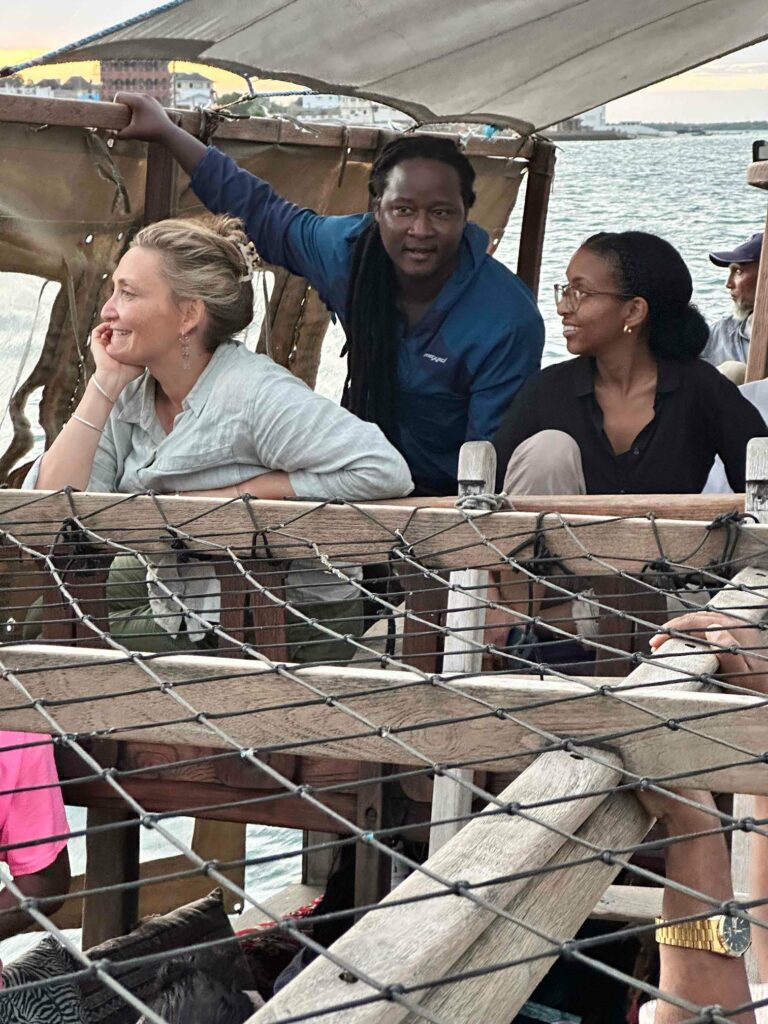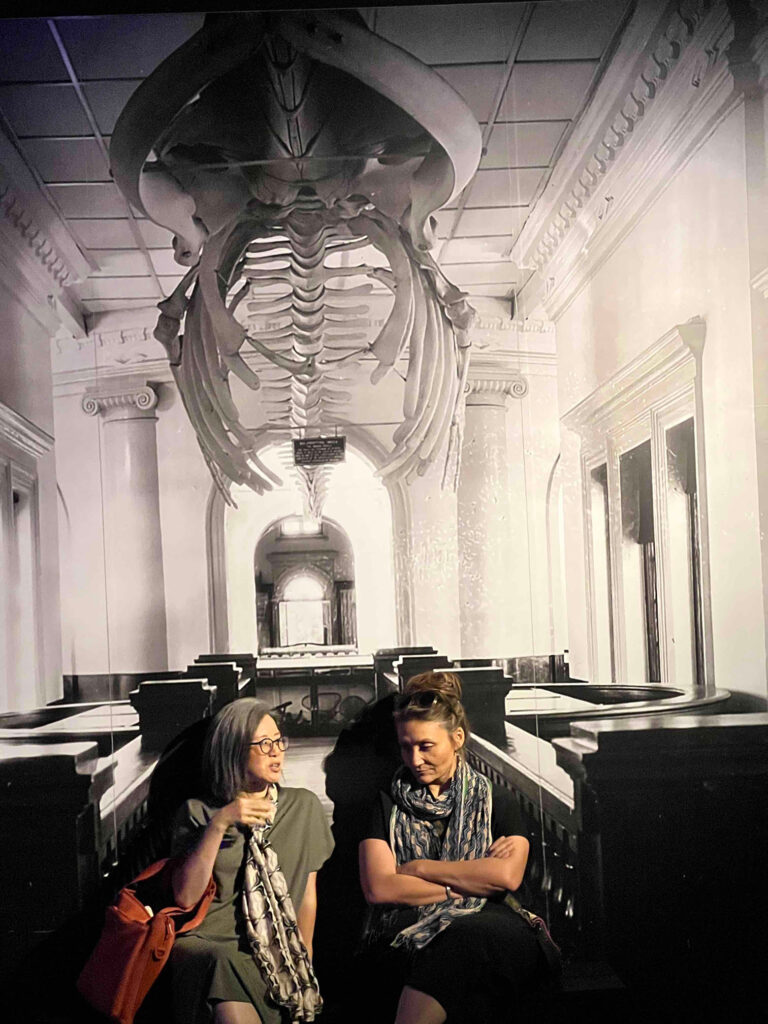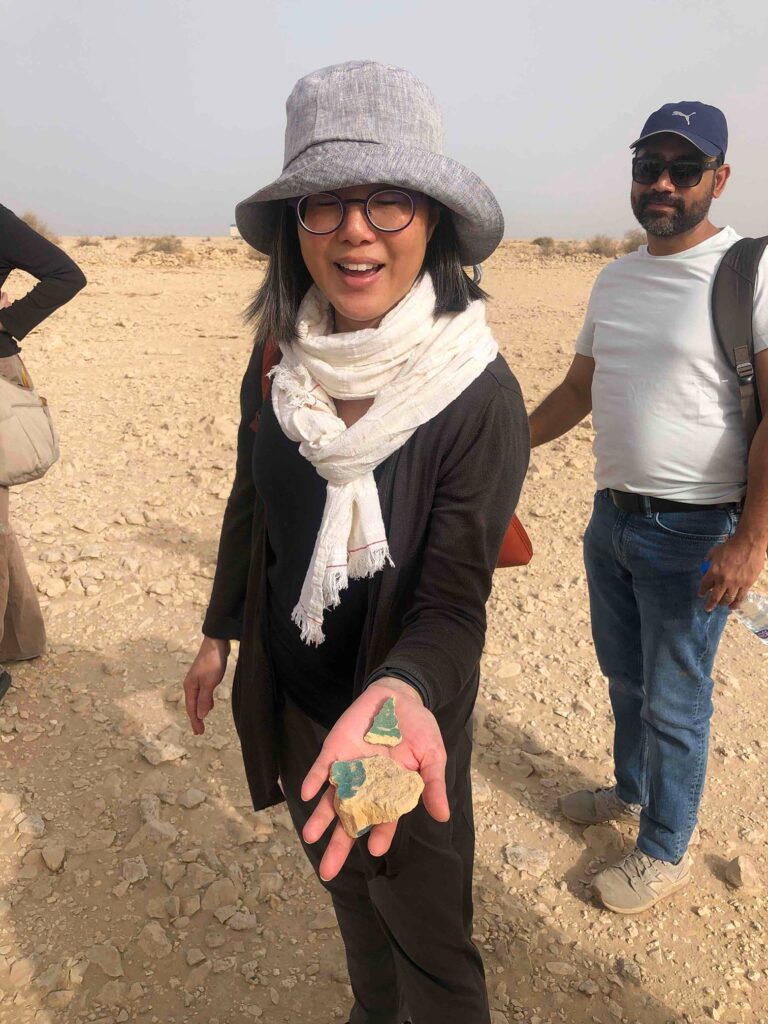Nancy Um and Prita Meier
On an early morning in Doha in May 2022, we convened the Indian Ocean Exchanges participants, for the first time in person, with the mantra: “All scholarship is social!” By doing so, we aimed to dispel the prevailing paradigm of the scholar hermit at a desk, buried under books and documents and writing in isolation. We kicked off this program by underlining that the work of forming a new and durable international community of rising scholars was itself an act of scholarly labor. After the initial lockdowns of COVID followed by Omicron, the notion of leaving our houses and traveling internationally (with all of its new restrictions) did indeed feel weighty on its own terms. These anxieties heightened the urgency of our charge. From the very beginning of the program, which was launched virtually in 2021, we had placed emphasis on site visits carried out as a group and intensive object work in museums and collections, positing these activities at the center of our intellectual production. Now, years later, the program has concluded its major activities: three international study trips to Doha in May 2022, Singapore in November 2022, and coastal Kenya in May 2023. As a final contribution of the collective group, we have compiled this online volume of short essays written by most of the participants in Indian Ocean Exchanges. Entitled Writing from the Water: New Perspectives in Indian Ocean Art Histories, it is intended to signal the possibilities ignited by communal scholarly work and undergirded by the promise of thinking across bodies of water as a research methodology.

As a group, these pieces spotlight the kinds of multi-sited questions that the Indian Ocean Exchanges program fostered, as we traveled the breadth of that ocean and worked to move beyond mere impressions of oceanic continuity or facile assertions in regard to long-distance exchange and itinerancy. Each of these essays draws on the three study trips that served as the centerpiece of the program. Some are based directly from observations taken at our various site visits, such as Helina Gebremedhen’s rumination on the colossal coffeepot roundabouts that dot western Indian Ocean port cities or Vidhita Raina’s essay that places a chintz jacket that we viewed at the Asian Civilisations Museum in Singapore in conversation with a Japanese robe crafted of Indian cotton. Others rely on ideas and knowledge shared by mentors and colleagues during our site visits. Dhaval Chauhan explores fluid notions of the public and private in the domestic architecture of Lamu, drawing directly on his experiences in that city. Vanessa Chen’s interactive mapping project examines the complexities of coastal heritage in eastern Africa, considering how national monuments simultaneously celebrate and occlude challenging histories and competing memories. Peering into archival sources and the drawers of the natural history museum, Gitanjali Pyndiah endeavors to provide a voice for long-lost animals, such as the iconic flightless biped of Mauritius, commonly referred to as the dodo. Simone Struth also looks at birds, highlighting the transoceanic journeys of the colorful parrots from Southeast Asia that have been memorialized on the surfaces of Chinese celadon wares, but also circulated across Indian Ocean trade networks. Faisal Husni describes his growing scholarly awareness of the sacred potential of forests, linking together spiritual practices between Kenya and Singapore. Celso Simbine also traverses the vast expanse of the Indian Ocean, by contemplating the meaning of important ceramic finds from both China and Europe, excavated in two related sites on Mozambique Island. These short essays have been written for a wide audience and are offered through the program website, which has served as an ongoing repository for our collective activities.
All of these pieces illustrate the scholarly value of travel, especially around the wide rim of the Indian Ocean, and how important it is to have a network of colleagues to help make sense of disparate and sometimes perplexing cross-oceanic connections, dependencies, and inequities. By doing so, we equalize the lived experience of scholarship with the labor of intellectual activity. The members of the program are exceptionally diverse in their backgrounds, interests, and worldviews. It is clear to us that the future of Indian Ocean art history and cultural studies, long dominated by voices in Europe, the UK, and North America, lies in the hands of interlocutors closer to that ocean itself. Experiencing the Indian Ocean world from the viewpoints of other program members fundamentally transformed all of our perspectives and research inquiries, program organizers and participants.
We, Nancy and Prita, first met decades ago, long before the inception of the Indian Ocean Exchanges program, at a time when Indian Ocean art history did not exist as a coherent subfield or subject of study. That was in the year 2001, when both of us were struggling to ask questions that could not be addressed within the limits of our respective fields of Islamic or African art history. Both of us were also at significant career junctures. Nancy was about to complete her dissertation at UCLA and was heading off for a new tenure-track position in New York. Prita had completed her MA at the University of Iowa and was choosing a doctoral program in African art history, which eventually led her to Harvard. At that time, we ruminated on our fortuitous meeting because we recognized in each other a desire to move beyond established art historical geographies and taxonomies. Our shared passion for the arts and architecture of Indian Ocean port cities inspired us to chart new paradigms that do not replicate established territorial frameworks and geopolitical divisions. We also both recognized that working on sites and themes of maritime connectivity requires collaboration. How can one become an “expert” on artworks and objects that represent far-reaching and overlapping cultural systems and societies shaped by long-distance migration and diaspora? Where do archipelagos, littorals and islands “belong” on the map of art history? These are the kinds of questions that animated our early conversations, which laid the seeds for continuing discussions on Indian Ocean art history, interactions that have endured and evolved for over two decades.

Indian Ocean Exchanges thus represents the culmination of our relationship and these new ones that were forged through the program, underlining that all scholarship is indeed social. The fellows are emerging voices in their fields, creating new, cutting-edge knowledge about the arts and aesthetics of the Indian Ocean world. Equally important, they have been cultivating each other’s scholarly growth and building their own foundational relationships across many sites, institutions, and fields of thought. They also worked with a diverse configuration of experts and practitioners in the three countries we visited during the Indian Ocean Exchanges program. Trinidad Rico, Rutgers University, joined the program in Doha, Imran bin Tajudeen, National University of Singapore, hosted the group in that city, and Athman Hussein of the National Museums of Kenya, led the cohort up and down the Swahili coast. All three were valuable contributors to the project. Two other international mentors joined our trips, Pam Smart, Binghamton University, traveled to Singapore and Kara Olidge, Getty Research Institute, traveled to Kenya. Radha Dalal, VCUarts Qatar, served as a generous thought partner throughout the whole program.
Taken together, these essays suggest that the new generation of scholars will transform previous paradigms of scholarship by not only centering oceans as sites of research and theorization, but also by putting new methodologies of care and exchange into practice. Certainly, for us, one of the most satisfying aspects of working on such an expansive topic as the Indian Ocean world is that it engenders collaborations across generations and continents.
This program was offered with the support of the Getty Foundation under its Connecting Art Histories initiative. The organizers and participants would like to thank Miguel de Baca, Senior Program Officer, Getty Foundation, for his dedication in helping to conceptualize it from its inception and for his generous input and support throughout the duration of the grant. Much gratitude is offered to Pam Smart, Associate Dean, Harpur College, Binghamton University, who served as co-PI in the program’s final year. Nancy and Prita would also like to heartily thank Lidia Ferrara who served as the Digital Content Manager on this volume. Lidia expertly laid out the articles, designed the pages, and brought the essays through the final steps of the editorial process.
Nancy Um currently serves as Associate Director for Research and Knowledge Creation at the Getty Research Institute, after a 20-year career of teaching art history, mentoring students, and serving as an administrator at Binghamton University. She is the author of The Merchant Houses of Mocha: Trade and Architecture in an Indian Ocean Port (University of Washington Press, 2009) and Shipped but Not Sold: Material Culture and the Social Protocols of Trade during Yemen’s Age of Coffee (University of Hawaii Press, 2017), in addition to other studies about trade, art, diplomacy, and gift exchange around the early modern Indian Ocean rim.
Prita Meier is associate professor of African and Indian Ocean art history at New York University. She is the author of Swahili Port Cities: The Architecture of Elsewhere (Indiana University Press, 2016) and The Surface of Things: A History of Photography from the Swahili Coast (Princeton University Press, 2024) and the co-editor of World on the Horizon: Swahili Arts across the Indian Ocean (Krannert Art Museum 2017).
Read the next essay: “Traversing the Indian Ocean: A Tale of Two Textiles” by Vidhita Raina >

